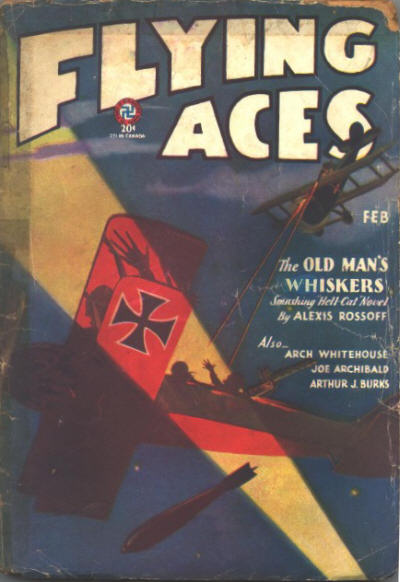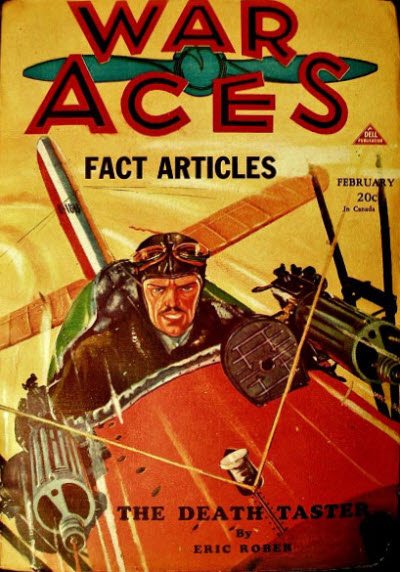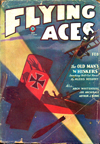“The Hardware Ace” by Joe Archibald
“HAW-W-W-W-W!† That sound can only mean one thing—that Bachelor of Artifice, Knight of Calamity and an alumnus of Doctor Merlin’s Camelot College for Conjurors is back to vex not only the Germans, but the Americans—the Ninth Pursuit Squadron in particular—as well. Yes it’s the marvel from Boonetown, Iowa himself—Lieutenant Phineas Pinkham!
That sound can only mean one thing—that Bachelor of Artifice, Knight of Calamity and an alumnus of Doctor Merlin’s Camelot College for Conjurors is back to vex not only the Germans, but the Americans—the Ninth Pursuit Squadron in particular—as well. Yes it’s the marvel from Boonetown, Iowa himself—Lieutenant Phineas Pinkham!
Following up on Phineas Carbuncle Pinkham’s introduction to the Ninth Pursuit Squadron and The Great Guerre, this month we have Pinkham’s second escapade from the February 1931 Flying Aces. Here, the Boonetown Ace inadvertently sparks a feud between the Ninth and their new neighbors—a French Squadron at Soirry Wood 20 ships and DeHavalind bombers would help them wreck Manheim’s Flying Circus and reclaim the air! Phineas turns to history for a lesson on how to win back the French when he puts on a little show as “The Hardware Ace!”
The C.O. should have known better. It was a friendly relations dinner for the new Frog squadron in that sector—and the Skipper let Phineas Carbuncle Pinkham come to the party!
“Synthetic Ace” by William E. Barrett
THIS November we’re celebrating William E. Barrett’s Birthday with one of his pulp stories each Friday.
Before he became renown for such classics as The Left Hand of God and Lilies of The Field, Barrett honed his craft across the pages of the pulp magazines—and nowhere more so than in War Birds and it’s companion magazine War Aces where he contributed smashing novels and novelettes, True tales of the Aces of the Great War, encyclopedic articles on the great war planes as well as other factual features. Here at Age of Aces Books he’s best known for his nine Iron Ace stories which ran in Sky Birds in the mid ’30s!
“Memphis†Mason is a synthetic ace,  probably the only one of his kind in existence. Accidental aces there were aplenty in that big he war, but there was nothing accidental about Memphis Mason’s accomplishment. It was planned with an attention to detail that would do credit to a brigadier and it was attested by five of the finest fighters in the R.A.F. Those signatures are at the root of Mason’s secret sorrow to-day. At the foot of a square sheet of note-paper they bear flourishing witness to the fact that the signers witnessed the bringing down of five German planes by one Memphis Mason. Not one of those signers would have lied for anyone. They were officers and gentlemen and they saw what they said they saw. Yet, strangely enough, Memphis Mason never reached France. Therein lies a tale; one of the oddest tales to come out of the war and one that has never been told until this telling.
probably the only one of his kind in existence. Accidental aces there were aplenty in that big he war, but there was nothing accidental about Memphis Mason’s accomplishment. It was planned with an attention to detail that would do credit to a brigadier and it was attested by five of the finest fighters in the R.A.F. Those signatures are at the root of Mason’s secret sorrow to-day. At the foot of a square sheet of note-paper they bear flourishing witness to the fact that the signers witnessed the bringing down of five German planes by one Memphis Mason. Not one of those signers would have lied for anyone. They were officers and gentlemen and they saw what they said they saw. Yet, strangely enough, Memphis Mason never reached France. Therein lies a tale; one of the oddest tales to come out of the war and one that has never been told until this telling.
There was a new breed of angel in the sky� one that used Vickers instead of a flaming sword; and the tracer stream of his vengeance spelled death to Prussians!
From the February 1931 War Aces, it’s William E. Barrett’s “Synthetic Ace!”
“The Night Bomber” by C. Heurlin
THIS week we present a cover by Colcord Heurlin! From 1923 to 1933 Colcord Heurlin painted covers for a wide range of pulp magazines. His work appeared on the covers of Adventure, Aces, Complete Stories, Everybody’s Combined with Romance, North-West Stories, The Popular, Short Stories, Sky Birds, Sea Stories, Top-Notch, War Stories, Western Story, and Flying Aces!
The Night Bomber
 THE tense drama of night bombing is clearly shown in the cover of this month’s issue. Many stories of these Boche bombing raids have been told. First the ominous whir of enemy wings sounded through the night. In the drome below, lights were hastily put out, and helmeted figures scurried to their ships to take to the air and ward off the dreaded danger. Streaks of Archie fire felt futilely through the black night sky for the range—and then the bombs fell, hurtling downward through the darkness on the tarmac beneath.
THE tense drama of night bombing is clearly shown in the cover of this month’s issue. Many stories of these Boche bombing raids have been told. First the ominous whir of enemy wings sounded through the night. In the drome below, lights were hastily put out, and helmeted figures scurried to their ships to take to the air and ward off the dreaded danger. Streaks of Archie fire felt futilely through the black night sky for the range—and then the bombs fell, hurtling downward through the darkness on the tarmac beneath.
Sometimes, as in our cover, an Allied ship took off in time to get above the bomber, and a powerful searchlight caught the German ship in its merciless glare. Then, though the Archie shells burst harmlessly about, death tracers from the sputtering Vickers above caught the German gunner. That was one ship that did not flee to Germany unscathed, leaving death and destruction behind.

“The Night Bomber”
Flying Aces, February 1931 by C. Heurlin
 That sound can only mean one thing—that Bachelor of Artifice, Knight of Calamity and an alumnus of Doctor Merlin’s Camelot College for Conjurors is back to vex not only the Germans, but the Americans—the Ninth Pursuit Squadron in particular—as well. Yes it’s the marvel from Boonetown, Iowa himself—Lieutenant Phineas Pinkham!
That sound can only mean one thing—that Bachelor of Artifice, Knight of Calamity and an alumnus of Doctor Merlin’s Camelot College for Conjurors is back to vex not only the Germans, but the Americans—the Ninth Pursuit Squadron in particular—as well. Yes it’s the marvel from Boonetown, Iowa himself—Lieutenant Phineas Pinkham! 




 probably the only one of his kind in existence. Accidental aces there were aplenty in that big he war, but there was nothing accidental about Memphis Mason’s accomplishment. It was planned with an attention to detail that would do credit to a brigadier and it was attested by five of the finest fighters in the R.A.F. Those signatures are at the root of Mason’s secret sorrow to-day. At the foot of a square sheet of note-paper they bear flourishing witness to the fact that the signers witnessed the bringing down of five German planes by one Memphis Mason. Not one of those signers would have lied for anyone. They were officers and gentlemen and they saw what they said they saw. Yet, strangely enough, Memphis Mason never reached France. Therein lies a tale; one of the oddest tales to come out of the war and one that has never been told until this telling.
probably the only one of his kind in existence. Accidental aces there were aplenty in that big he war, but there was nothing accidental about Memphis Mason’s accomplishment. It was planned with an attention to detail that would do credit to a brigadier and it was attested by five of the finest fighters in the R.A.F. Those signatures are at the root of Mason’s secret sorrow to-day. At the foot of a square sheet of note-paper they bear flourishing witness to the fact that the signers witnessed the bringing down of five German planes by one Memphis Mason. Not one of those signers would have lied for anyone. They were officers and gentlemen and they saw what they said they saw. Yet, strangely enough, Memphis Mason never reached France. Therein lies a tale; one of the oddest tales to come out of the war and one that has never been told until this telling.
